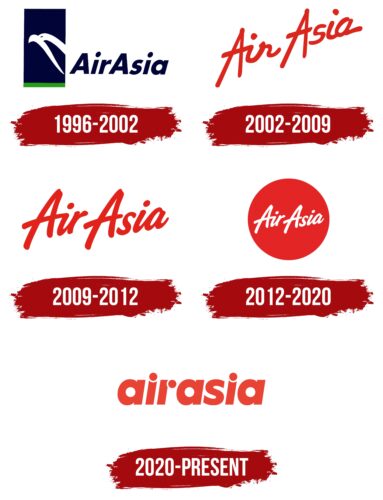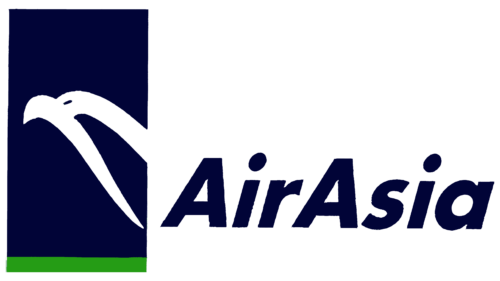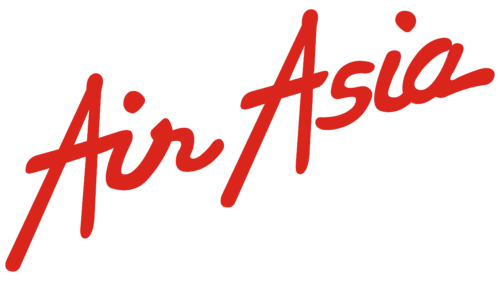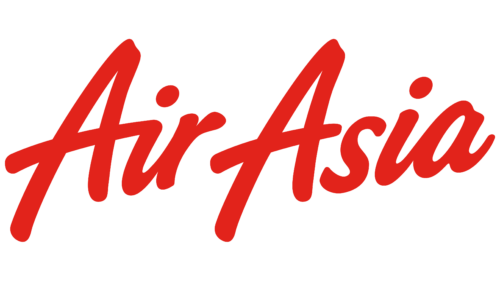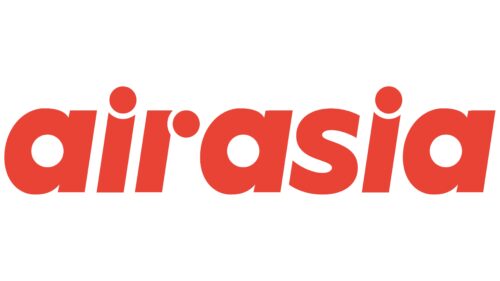The AirAsia logo represents the company’s status as a leading low-cost airline in Asia-Pacific. AirAsia aims to make air travel affordable for a wide range of people. The logo’s dynamic and modern design reflects AirAsia’s innovative business approach, revolutionizing budget air travel in the region.
AirAsia: Brand overview
The government-owned business DRB-HICOM founded AirAsia in 1993 as a traditional airline operating within Malaysia on internal routes. In its early years, the business had severe financial problems and could not compete with bigger, well-established carriers.
A significant development in the company’s history took place in 2001. Former Warner Music executive Tony Fernandes and a group of investors acquired the faltering airline for a symbolic 1 Malaysian ringgit (about $0.25 USD), taking on 40 million ringgit in debt. Fernandes wanted to make the airline the first profitable low-cost airline in Asia.
In 2002, Fernandes took the helm as the company transitioned into a low-cost carrier. The business decreased tickets, streamlined operations, and reduced costs by adopting a model akin to that of Ryanair in Europe and Southwest Airlines in the US, which resulted in a notable increase in passenger volume.
With the opening of new local destinations and the introduction of international flights to nearby nations like Thailand and Indonesia, the company aggressively grew its route network in 2003. Additionally, the business introduced internet ticket sales to the area, which was a novel idea at the time.
By establishing Thai AirAsia, a joint venture in Thailand, the company expanded internationally in 2004. Fernandes’ plan to establish a pan-regional airline began with this.
The business established a long-haul subsidiary, AirAsia X, in 2007 to provide service for journeys longer than four hours. This was a creative move, given that the budget model was previously considered unfit for long-haul travel.
In 2010, AirAsia Japan (later rebranded as Vanilla Air) and Philippines AirAsia were founded as part of the company’s ongoing regional growth. These actions enhanced the company’s position in the Japanese and Philippine markets.
By becoming the largest shareholder in Indonesia AirAsia and considerably growing its route network throughout the country, the business strengthened its position in Indonesia in 2012 by raising its ownership to 49%.
Despite the difficult regulatory environment in India, the company formed a joint venture in 2013 called AirAsia India to enter the market. This action increased the business’s visibility in one of the biggest aviation markets globally.
In 2016, as part of a corporate reorganization, the company established AirAsia Group Berhad as the holding company to oversee its numerous affiliates and subsidiaries. This action improved divisional cooperation and operational efficiency.
The firm started a digital transition in 2018 and introduced several digital projects, such as the AirAsia BIG reward program and travel portal. These initiatives increased the variety of services provided and enhanced the client experience.
As a “super app,” the company launched its platform AirAsia.com in 2019 and integrated a range of services, including shopping, food delivery, and travel bookings. This was a crucial move to expand its position in the digital services market and diversify its business.
Meaning and History
Since its founding in 1993, the AirAsia logo has undergone several changes but has always kept recognizable elements that showcase the brand’s dynamic nature and spirit of innovation. Red dominates AirAsia’s branding, symbolizing passion, energy, and boldness. These qualities reflect the company’s approach to business and customer service.
What is AirAsia?
Established in 1993, AirAsia has become a leading low-cost airline in Malaysia, transforming affordable air travel throughout the Asia-Pacific region. The airline offers competitive prices and covers many destinations across Southeast Asia, East Asia, Australia, and New Zealand. Due to its innovative approach to reducing costs and improving efficiency, The airline has opened air travel to more people. This strategy has made flying more accessible and has boosted tourism and economic development in the area.
1996 – 2002
Since its start in 1996 up until 2002, AirAsia has been on a path to becoming a major force in the airline industry, a journey echoed in its logo. This logo, featuring a dark blue rectangle with a green stripe at the bottom, pays homage to the Malaysian flag, showing the airline’s roots and pride in its country. The choice of a dark blue symbolizes the airline’s serious ambitions and national pride.
At the heart of the logo is a white eagle, symbolizing strength and the majestic way this company aims to conquer the skies, much like an eagle soaring above. This image is a strong statement of the airline’s power and goals to stand out in the aviation world. The green stripe represents Malaysia’s rich landscapes, connecting the airline to its home’s natural beauty.
The logo’s design, aiming upwards, represents the company’s ambitions and promise for a bright future. It reflects the airline’s goal to keep reaching higher, exploring new opportunities, and its determination to be a leader in international travel. This emblem captures the company’s spirit of growth and relentless drive to excel in the competitive world of aviation.
2002 – 2009
The new AirAsia logo features the company name in a thin, red cursive font, symbolizing the brand’s growth. This design, which looks like the company’s planes taking off, represents AirAsia’s expansion, especially with its move into long-haul flights. This shift reflects the transition from traditional Malaysian themes to a broader, international appeal.
Red was chosen for its association with fast development, the airline’s wide network, and its popularity. It highlights AirAsia’s dynamic and passionate approach, setting it apart in the aviation industry. The airline is known for its affordable prices, making it popular with local communities, a quality the logo captures well.
The cursive font makes AirAsia seem friendly and committed to close customer relationships. It underscores the airline’s goal to offer low-cost flights without sacrificing service. The logo, resembling a red bird, stands for speed, flexibility, and the lively spirit of Asia. It shows AirAsia as an efficient, hospitable airline that connects travelers to Asia’s rich culture at a good value.
2009 – 2012
AirAsia’s logo got a font update, making it look neater and more cohesive, which aligns with its reputation as a leading budget airline. This change is more than cosmetic; it shows AirAsia’s commitment to improving service quality and comfort. By investing in advanced, costly planes, AirAsia emphasizes its focus on safety and reliability and aims for excellence in the airline industry.
The logo’s new font reflects AirAsia’s goal for perfection and its efforts to enhance the flying experience with the latest technology and aircraft designs. This updated logo represents AirAsia’s innovative spirit and high standards for every part of its service.
2012 – 2020
AirAsia smartly added Japan’s red sun to its logo to celebrate its Japanese division’s opening. This choice connects the airline’s brand with Japanese culture. The red sun, an important part of Japan’s flag, aims to make Japanese customers feel a familiar warmth towards this aviation company. The white text within this sun signifies a fresh start, showing the company’s focus on innovation and growth.
The airline honors Japan’s heritage by using the red and white colors of the Japanese flag. This decision aims to appeal to Japanese people by tapping into the cultural importance of these colors. It shows the airline’s respect for Japanese traditions and its desire to form a positive bond with travelers from Japan.
2020 – today
Capital A’s rebranding significantly changed the brand’s look, introducing bold red letters to symbolize growth and the airline’s evolution. This shift wasn’t just for show; it highlighted the company’s expansion into five more countries over eight years, showing its ambition to reach wider and grow further.
The logo’s new feature, three round dots, adds deep meaning beyond decoration. Each dot represents a key city or hub, emphasizing AirAsia’s vast network and its role in connecting different places. These dots also showcase the airline’s attention to detail and commitment to high-quality service, ensuring travelers have a smooth and memorable experience.
This rebranding and the redesigned logo reflect AirAsia’s mission to make flying affordable and pleasant and to connect people and cities efficiently. They are a visual promise of the airline’s dedication to expanding its services and enhancing customer travel experiences.
FAQ
What are the colors of AirAsia?
AirAsia is known for its bright red color, which has been a key part of its look since the start. This red is everywhere – on its planes, in ads, on the crew’s outfits, and inside the planes. The color makes the company easy to spot and stands for its drive, excitement, and promise to make flying affordable for everyone. Choosing red was smart because red is often seen as strong and daring. It shows the company’s goal to shake things up in flying by offering cheap flights, making it easier for more people to travel.
What font does AirAsia use?
This aviation enterprise uses a main font called Gotham Rounded. It’s chosen for its bold, friendly look and ease of reading, which match the company’s friendly vibe. This flexible font, with different thicknesses, from light to bold, works well for the company’s needs. The aviation operator also uses two other fonts to add fun to its style: Cocogoose Pro and The Wild Things. These fonts bring in more energy and change, making the company’s messages stand out. Both have various styles, giving the company many options for its look.
What is the motto of AirAsia?
The company’s slogan, “Now Everyone Can Fly,” clearly identifies its goal of making air travel accessible to more people. The main goal is to enable more people to explore new destinations, encounter diverse cultures, and connect with different individuals without breaking the bank. The company has successfully maintained low fares while ensuring flights remain safe and enjoyable. This slogan reflects the operational strategy. The company passes these savings to its customers by finding efficient ways to reduce expenses.
What is the symbol of AirAsia?
The company’s logo is widely recognized for its bold white letters on a vivid red background. Before 2001, the logo featured a bird. However, the company revamped its appearance and logo to reflect its core values more accurately. The red in the logo captures attention and represents excitement, energy, and the company’s commitment to making flying accessible to a broader audience. The white text stands for clarity, safety, and hope, emphasizing the company’s dedication to customer satisfaction and operational efficiency. The logo embodies the company’s slogan, “Now Everyone Can Fly,” highlighting its goal to make air travel affordable and accessible to many people.

